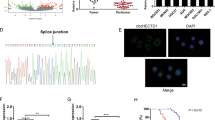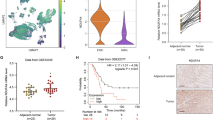Abstract
We identified gamma-glutamyltransferase 7 (GGT7) to be frequently downregulated in gastric cancer, but its role remains unknown. Here we elucidated the clinical significance, functional roles, and molecular mechanism of GGT7 in gastric cancer. GGT7 was downregulated by promoter methylation and restored by demethylation treatment in gastric cancer cells. GGT7 methylation inversely correlated with mRNA expression in gastric tumors (n = 221; r = −0.686, P < 0.0001). High-expression of GGT7 in adjacent non-tumor tissues was significantly associated with favorable survival in gastric cancer patients (n = 138; P = 0.009), and was an independent prognostic factor by multivariate Cox regression (HR = 0.381, P < 0.05). GGT7 significantly inhibited gastric cancer cell growth, G1-S transition, and migration and invasion abilities. GGT7 also significantly attenuated the growth of subcutaneous xenograft tumors and reduced metastasis to the lung in nude mice. The mitophagy regulator RAB7 was identified as a direct downstream co-player of GGT7 by co-immunoprecipitation followed by mass spectrometry. Growth suppression effect of GGT7 was at least partly dependent on RAB7 by rescue experiments. GGT7 induced autophagy as shown by electron microscopy and confirmed by the increased LC3B and decreased p62. GGT7 recruited RAB7 by direct binding and drove RAB7 to translocate from nucleus to cytoplasm, subsequently mediating mitophagy by increasing mitophagy mediators/inducers. GGT7 inhibited intracellular ROS, which was associated with increased mitophagy, and subsequently suppressed MAPK signaling. Collectively, GGT7 plays a pivotal tumor-suppressing role in gastric cancer by directly binding with RAB7 to induce mitophagy and inhibit ROS and MAPK cascades. GGT7 is an independent prognostic factor for gastric cancer patients.
This is a preview of subscription content, access via your institution
Access options
Subscribe to this journal
Receive 50 print issues and online access
$259.00 per year
only $5.18 per issue
Buy this article
- Purchase on Springer Link
- Instant access to full article PDF
Prices may be subject to local taxes which are calculated during checkout







Similar content being viewed by others
References
Camargo MC, Kim WH, Chiaravalli AM, Kim KM, Corvalan AH, Matsuo K, et al. Improved survival of gastric cancer with tumour Epstein-Barr virus positivity: an international pooled analysis. Gut. 2014;63:236–43.
Choi IS, Wu TT. Epigenetic alterations in gastric carcinogenesis. Cell Res. 2005;15:247–54.
Otani K, Li XX, Arakawa T, Chan FKL, Yu J. Epigenetic-mediated tumor suppressor genes as diagnostic or prognostic biomarkers in gastric cancer. Expert Rev Mol Diagn. 2013;13:445–55.
Qian HR, Yang Y. Functional role of autophagy in gastric cancer. Oncotarget. 2016;7:17641–51.
Kongara S, Karantza V. The interplay between autophagy and ROS in tumorigenesis. Front Oncol. 2012;2:171.
Filomeni G, De Zio D, Cecconi F. Oxidative stress and autophagy: the clash between damage and metabolic needs. Cell Death Differ. 2015;22:377–88.
Yamano K, Fogel AI, Wang C, van der Bliek AM, Youle RJ. Mitochondrial Rab GAPs govern autophagosome biogenesis during mitophagy. eLife. 2014;3:e01612.
Heisterkamp N, Groffen J, Warburton D, Sneddon TP. The human gamma-glutamyltransferase gene family. Hum Genet. 2008;123:321–32.
Bui TT, Nitta RT, Kahn SA, Razavi SM, Agarwal M, Aujla P, et al. gamma-Glutamyl transferase 7 is a novel regulator of glioblastoma growth. BMC Cancer. 2015;15:225.
Bui TT, Nitta RT, Kahn SA, Razavi SM, Agarwal M, Aujla P, et al. gamma-Glutamyl transferase 7 is a novel regulator of glioblastoma growth. BMC Cancer. 2015;15:225.
Lim JS, Yang JH, Chun BY, Kam S, Jacobs DR, Lee DH. Is serum gamma-glutamyltransferase inversely associated with serum antioxidants as a marker of oxidative stress? Free Radic Bio Med. 2004;37:1018–23.
Wang K, Liang Q, Li X, Tsoi H, Zhang J, Wang H, et al. MDGA2 is a novel tumour suppressor cooperating with DMAP1 in gastric cancer and is associated with disease outcome. Gut. 2016;65:1619–31.
Li X, Liang Q, Liu W, Zhang N, Xu L, Zhang X, et al. Ras association domain family member 10 suppresses gastric cancer growth by cooperating with GSTP1 to regulate JNK/c-Jun/AP-1 pathway. Oncogene. 2016;35:2453–64.
Yu J, Liang Q, Wang J, Wang K, Gao J, Zhang J, et al. REC8 functions as a tumor suppressor and is epigenetically downregulated in gastric cancer, especially in EBV-positive subtype. Oncogene. 2017;36:182–93.
Yu J, Liang Q, Wang J, Cheng Y, Wang S, Poon TC, et al. Zinc-finger protein 331, a novel putative tumor suppressor, suppresses growth and invasiveness of gastric cancer. Oncogene. 2013;32:307–17.
Liang Q, Yao X, Tang S, Zhang J, Yau TO, Li X, et al. Integrative identification of epstein-barr virus-associated mutations and epigenetic alterations in gastric cancer. Gastroenterology. 2014;147:1350–62 e1354.
Magnelli L, Schiavone N, Staderini F, Biagioni A, Papucci L. MAP kinases pathways in gastric cancer. Int J Mol Sci. 2020;21:2893.
Ho CJ, Gorski SM. Molecular mechanisms underlying autophagy-mediated treatment resistance in cancer. Cancers (Basel). 2019;11:1775.
Jimenez-Orgaz A, Kvainickas A, Nagele H, Denner J, Eimer S, Dengjel J, et al. Control of RAB7 activity and localization through the retromer-TBC1D5 complex enables RAB7-dependent mitophagy. EMBO J. 2018;37:235–54.
Guerra F, Bucci C. Multiple roles of the small GTPase Rab7. Cells. 2016;5:34.
Carroll B, Mohd-Naim N, Maximiano F, Frasa MA, McCormack J, Finelli M, et al. The TBC/RabGAP Armus coordinates Rac1 and Rab7 functions during autophagy. Dev Cell. 2013;25:15–28.
Yang XZ, Li XX, Zhang YJ, Rodriguez-Rodriguez L, Xiang MQ, Wang HY, et al. Rab1 in cell signaling, cancer and other diseases. Oncogene. 2016;35:5699–704.
Zhang M, Chen L, Wang S, Wang T. Rab7: roles in membrane trafficking and disease. Biosci Rep. 2009;29:193–209.
Zhao T, Ding X, Yan C, Du H. Endothelial Rab7 GTPase mediates tumor growth and metastasis in lysosomal acid lipase-deficient mice. J Biol Chem. 2017;292:19198–208.
Alonso-Curbelo D, Riveiro-Falkenbach E, Perez-Guijarro E, Cifdaloz M, Karras P, Osterloh L, et al. RAB7 controls melanoma progression by exploiting a lineage-specific wiring of the endolysosomal pathway. Cancer Cell. 2014;26:61–76.
Alonso-Curbelo D, Osterloh L, Canon E, Calvo TG, Martinez-Herranz R, Karras P, et al. RAB7 counteracts PI3K-driven macropinocytosis activated at early stages of melanoma development. Oncotarget. 2015;6:11848–62.
Son Y, Cheong YK, Kim NH, Chung HT, Kang DG, Pae HO. Mitogen-activated protein kinases and reactive oxygen species: how can ROS activate MAPK pathways? J Signal Transduct. 2011;2011:792639.
Bloemberg D, Quadrilatero J. Autophagy, apoptosis, and mitochondria: molecular integration and physiological relevance in skeletal muscle. Am J Physiol Cell Physiol. 2019;317:C111–C130.
Yu J, Cheng YY, Tao Q, Cheung KF, Lam CN, Geng H, et al. Methylation of protocadherin 10, a novel tumor suppressor, is associated with poor prognosis in patients with gastric cancer. Gastroenterology. 2009;136:640–51 e641.
Acknowledgements
The project was supported by the RGC-GRF Hong Kong (14116418), National Nature and Science Foundation of China (81773000), RGC-GRF Hong Kong (C7065-18GF), and Vice-Chancellor’s Discretionary Fund CUHK.
Author information
Authors and Affiliations
Contributions
JQL and JY conceived and designed the study. XW, JQL, and LZ contributed to the carrying out of the experiments. XW, JQL, FKLC, and JJ contributed to the data analysis. XW and JQL wrote the manuscript. All authors read and approved the final manuscript.
Corresponding authors
Ethics declarations
Competing interests
The authors declare no competing interests.
Additional information
Publisher’s note Springer Nature remains neutral with regard to jurisdictional claims in published maps and institutional affiliations.
Supplementary information
Rights and permissions
About this article
Cite this article
Wang, X., Zhang, L., Chan, F.K.L. et al. Gamma-glutamyltransferase 7 suppresses gastric cancer by cooperating with RAB7 to induce mitophagy. Oncogene 41, 3485–3497 (2022). https://doi.org/10.1038/s41388-022-02339-1
Received:
Revised:
Accepted:
Published:
Issue Date:
DOI: https://doi.org/10.1038/s41388-022-02339-1



